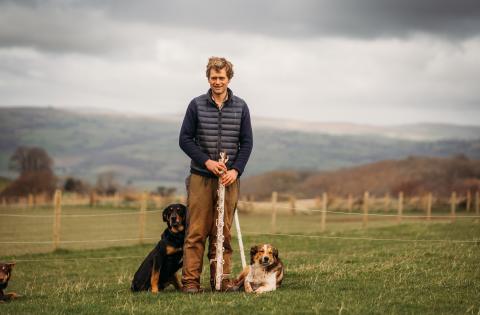EXECUTIVE SUMMARY
Farming Connect study informs sheep farmer’s switch to regenerative agriculture
A sheep farmer is introducing sweeping changes to his system by establishing a regenerative approach to farming.
Will Sawday had been interested in low cost farming models and utilising grazed grass before embarking on his Farming Connect Management Exchange study.
“The regenerative farming concept grasped my attention and seemed like a natural progression for our business,’’ said Mr Sawday.
That business revolves around a flock of 1,400 New Zealand Romneys, run on 227 hectares on a forage-only, low-input system.
Mr Sawday said his study had enabled “some fantastic conversations with some inspiring people who have ultimately shown me how regenerative agriculture can derive a prosperous farming business.’’
“It has really made me question some of the things we do on our farm, and how this topic can find solutions to some of our challenges,’’ he said.
He is already putting some of the ideas to the test, including operating a mobile chicken shed which he moves around the farm, following his sheep, to produce pasture-raised eggs to sell.
“We approached a couple of shops, restaurants and bakers, and it was an immediate success,’’ he said.
There has also been a change to how forage crops are established.
Based on the advice of two farmers he visiting during his study, Mr Sawday now uses half rate glyphosate mixed with fulvic acid to improve the effectiveness of this input at low rates but buffering against any potential damage to soil microbiology.
He then applies chicken muck and direct drills a mix of swedes and kale.
The results overall had been good, he said, with “a couple of great crops that have cost us very little.’’
But he added: “There have also been a couple of poor ones, but we think we know why, and what we could have done to improve them. It’s certainly a learning curve, but definitely a direction we should be heading in.’’
As he looks to the future, at the top of Mr Sawday’s list is improving soil health and function.
“The benefits of this are endless, both financially and environmentally,’’ he said.
“Soil health is the driver of all financial, environmental and social outcomes. It will make or break us.’’
Closely linked to this should be resilience-building to safeguard the business from market and climatic variations, he added.
“I think reduction of costs and improvements in plant and animal health would be outcomes that allow this to happen.’’
Going forward, Mr Sawday aims to eliminate fertiliser and chemical usage, including anthelmintics, stopping cultivating the soil and encouraging diversity to pastures, by introducing seed and with grassland management.
“Mixed species permanent pastures are king. Not only are they more resilient than rye grass leys but they can be just as productive and can offer better animal nutrition,’’ said Mr Sawday.
He will adopt a system of grazing tall grass too.
“The benefits of allowing grass to mature are undeniable but managing a profitable flock of sheep on it though might, in my mind, be tricky. Either way it must be tried,’’ he insisted.
He will also introduce cattle as these, he believed, would be a “huge asset’’ to pastures and help to develop soil and pasture health.
“Further, they might help to utilise all that mature grass I will be growing,’’ said Mr Sawday.
He also plans to introduce more in-field trees - a “big step in getting some resilience back into the farm’’ – and pollard these to produce tree fodder and biomass.
Mr Sawday said he had learned that profitable livestock businesses can be maintained under a regenerative system.
In most cases overall production can be less than traditional high-input, high-output systems, he suggested.
“With escalating input prices, I should think more people will turn to these types of lower-input systems as high-input, high-output systems become increasingly volatile.
“I am under no illusion that there isn’t much that is new about regen farming, most of the concepts are as old as farming itself.’’
But farmers are now having to re-learn those skills.
“In addition to the financial and environmental benefits, there is interestingly a lot of work being done comparing soil health with human health and unsurprisingly when you grow food in healthy soil it has greater nutrient density and will offer better health to the consumer,’’ said Mr Sawday.
“When you add all these elements together, I would not be surprised if the public and government imminently start asking for their food to be grown under regenerative farming systems.’’
MANAGEMENT EXCHANGE REPORT:


